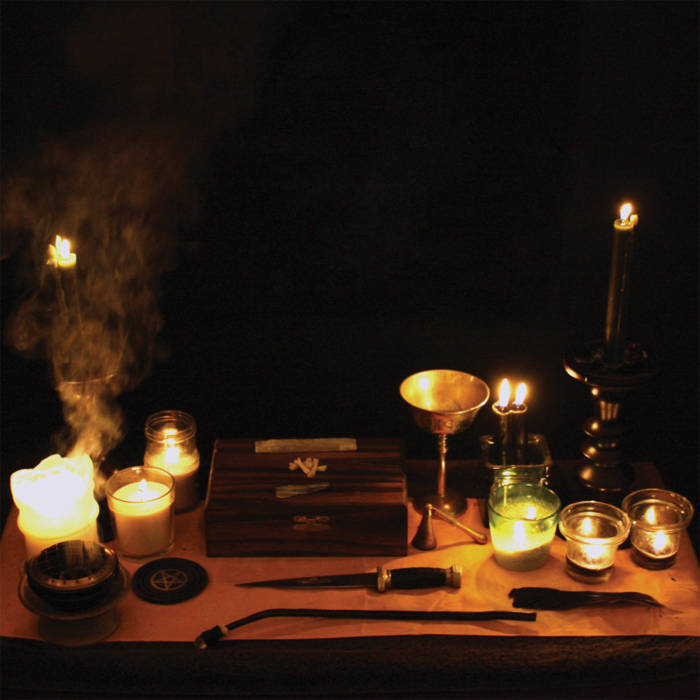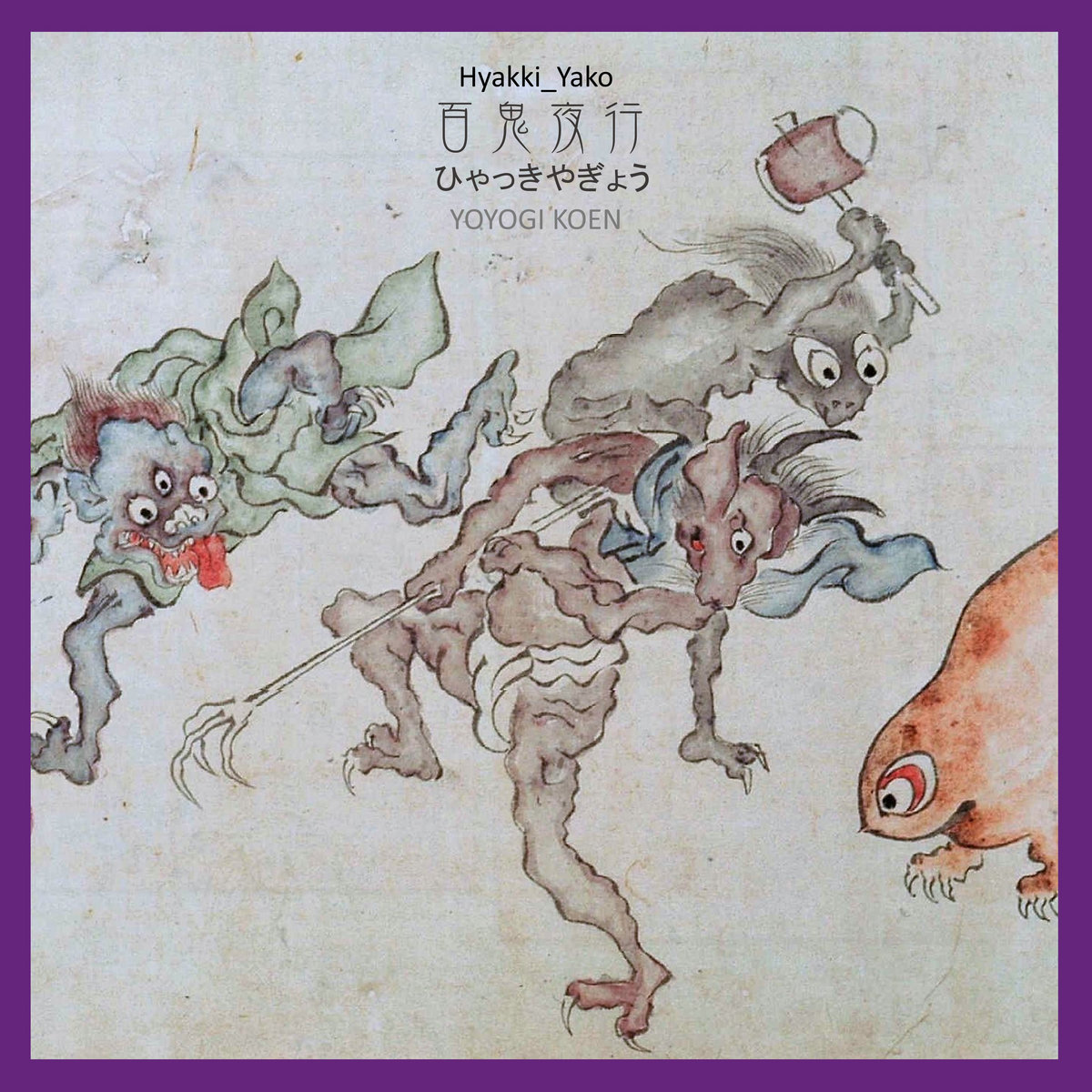Spooky season is upon us—and so is another Bandcamp Day. As we prepare ourselves for the upcoming hellish holiday of Halloween, we've been perusing Bandcamp in search of releases that capture the spirit of the season—and we've turned up everything from intricate, interwoven sound design to eerie, edgy ambiences and delightful demonic parades. Take some time today to scope out all the odd and eerie things you can track down on Bandcamp: some things will send a chill down your spine, and some will prove to provide the perfect ambiance for your seasonal seance.
Dark Ambiences: Sutekh Hexen's Behind the Throne
Although my current taste in music may not always suggest it, a significant portion of my life was spent immersed in extreme genres of music—particularly in the realm of metal. My usual inclinations in music have since mellowed out quite a bit, favoring ambient or experimental electronic music dwelling in territories that are both subtle and evocative, though I am often pleased to stumble upon music which manages to bridge the gap between my current and prior musical preferences. After all, much of the dark ambient genre evolved out of traditional ambient music but with a bit of an edge to it.

Combining dark ambient tendencies with the sounds of black metal, Sutekh Hexen's Behind the Throne easily checks all the boxes of genre crossovers for me. Black metal has never been a genre with pristine production quality—in fact, the murky melding of high gain guitars against harsh vocals only enhances the decidedly bleak aesthetic of the music. But where Sutekh Hexen lacks the drums typically heard in their genre, their music is supplemented with rushes of noise and distorted layers of metallic sounds in a way that's rather reminiscent of the work of artists like Tim Hecker. Long sustained guitar chords underneath feedback and otherworldly reversed sounds easily complement the textural, screaming vocals nearly drowned out by everything in the sonic space around them.
Consisting of just two tracks at fifteen minutes each, Behind the Throne leaves plenty of breathing room to dwell in the brooding moods conjured up by Sutekh Hexen. The first track initially leans more upon their black metal influences, leading with droning guitar and vocals for a significant portion of the track. By the end, more noise and rumbling textures are introduced to plunge the listener further into the swirling sonic darkness. On the other hand, track two begins in a slow build of shadowy ambience, with nearly four minutes going by before a guitar appears. Behind the Throne is not a fast-moving piece of music, rather it extensively blends sonic moments with blurred transitions—very few moments of distinct change occur, but when they do it makes the impact that much more powerful.
Ambient music is often thought to be gentle and subtle, but in actuality can cover a broad spectrum of musical styles, much as the range of human emotions is broad and full of simple and complex feelings. As such, applying the instrumentation and stylings of black metal to ambient music results in something that anyone would consider sufficiently haunted and spooky, which Sutekh Hexen delivers with expertise.
A Parade of Demons: Yoyogi Koen's Hyakki Yako
In Japanese folklore, the Night of One Hundred Demons (百鬼夜行, Hyakki Yako) is an evening in the Summer when all the supernatural creatures, known as Oni 鬼 and Yokai 妖怪 parade in the street. Any mortal unlucky enough to come across this procession would be swept away into the spirit world. In Hyakki Yako, by Yoyogi Koen, 5 of these spirits are given short compositions that outline their essence. Using sparse synth arrangements, each of these tracks have a certain motion that feels connected and yet unique—more vignettes than songs.

Kappa「河童」 and Kodama「木霊」 are two tracks that stand out. Kappa, meaning "River Child," is a burbling, suspicious creep of a track that gives you the sense of these strange river creatures. According to legend, they have a small dish on the top of their head which holds their power and life force—if ever it dries out, they could perish or become powerless. Sometimes menacing, other times tricksters, you get the sense of tension and distrust by listening to this and, indeed, feels like a shade of the Kappa.
Kodama, popularized by the classic film Princess Mononoke, are spirits that inhabit trees. They don't always take a physical form and are often depicted as a tree itself, only revealing its nature when chopped down, cursing the one who felled it. Less malicious and more whimsical, the track takes a slower, more arboreal approach and is appropriately the longest track. A long harmonically rich drone carries us through while the buzz of cricket-like-sounds weave in and out giving a sense of majesty and peace, like a serene purgatory.
Released via Hong Kong label, 433 Records, the limited edition floppy disk is already sold out, however, the digital version has one track that is smashed and compressed which imparts a wonderfully haunted feel. This won't scare you, but just like the friendly spector in your apartment building that watches you, or the decidedly haunted back corner by the overgrown alley entrance, this album gives you a sense of curious tension.
Hyper Horror: Yen Tech's Assembler
Hyper-realistic sound design's use case varies widely across music and film, and over the past few years, it has become an incredible source of inspiration for reinventing genres. While sometimes posed as goofy, pristine, or bopping in the mainstream, the fantastical and other-worldly interpretations of such sound design rarely gain such attention, and their implementations aren't always dancefloor friendly. Yen Tech's Assembler is a gem of the underground electronic music scene that offers cinematic and maximalist sonic contours, morphing constantly between off kilter beauty and utter destruction. Released on the Shanghai label SVBKVLT, Assembler evokes intensity and ruin, intertwining an almost raspy and choked narrator and their unruly habitat, including angelic siren, animalistic roars and buzzes, and gloomy and apocalyptic settings that portray an abysmal future.

Tantalizing buildups continuing to build upon themselves and proceeding to non-traditional drops can be heard in the tracks "Sentry" and "Herd", while more ethereal, dream-like and melodious vocals ground you in the chaotic storm of sound heard in "Tesserae" and "Exegesis". One of the most thrilling and terrifying things in life is not knowing what comes next, and Yen Tech pushes this existential boundary to new limits with tracks that devolve into a representative nothingness, a void that you hover over, heard toward the ends of "Arsenal", "Leech", and the title track "Assembler". Assembler's sonic nature that births, dies, and revives in a constant cycle presents uncertainty in understanding where each sound begins and ends, but rather than left feeling disillusioned, you as the listener are empowered to immerse yourself in this demented, technological soundscape of doom and despair. Such immersion allows you to take in the brilliant uses of granular synthesis, time stretching, and a wide array of effect processing Yen Tech layers throughout.
What's brilliant about Assembler is its thematic continuity, always mutating while keeping to the spooky, robotic setting. Subtle and drastic changes in how the drums play or the voices sing out offer a dynamic setting for storytelling, and with sparse interludes that shine on a softer side of the album, the narrator's main goal always seems to be in favor of evolution and metamorphosis. One of the tracks that offer a break away from narration include "Leech", a cadenza on this ultra-piano/harpsichord that falls apart halfway through, only to reintegrate you back into the main plot. Another track, "Kernel", is one of the more drastic shifts in the album, bringing you to a much more natural setting of blowing winds and crickets chirping in a forest. The album ends with the track "Helix Sky" where we listen to this wondrous harp solo that transforms into a warm and beautiful looping synth, deceptively resolving from the majority of the album's dismal characteristic. I find myself latching to every corner of Assembler, and I invite you to explore the realm in which Yen Tech has laid out.
Humorous, Horrific Guitar-Scapes: Nick Reinhart's Scary Sounds
Every year around halloween, I revisit an old favorite trio of seasonal albums—Nick Reinhart's Scary Sounds (2013), Scary Sounds II (2014), and Scary Sounds III (2015). Designed to strike fear into the hearts of partygoers and trick-or-treaters, these albums also provide for a compelling listening experience all the year round: so if you like peculiar horror movie soundscapes with a tongue-in-cheek sense of humor, odds are that these will be right up your alley.

Known for his involvement in the somewhat-punk/somewhat-math-rock group Tera Melos, Reinhart is a wonderfully inventive guitarist. One of the most definitive parts of his practice is his idiosyncratic, inventive use of effect processing—using guitar and a constantly-shifting array of pedals to create everything from chorused, spacey washes to robotic jackhammers and CD-skipping freakouts. In live performance, this often means using pedal effects in the style of live remixing, momentarily engaging effects to create jarring transitions between sections, or to generate peculiar rhythmic counterpoint to his live playing.
Despite how it might initially seem, the Scary Sounds series doesn't include synthesizers at all—it is entirely comprised of the sounds of Reinhart's guitar with copious amounts of processing. Layered to create horrific howling soundscapes straight out of a Carpenter film, it's the perfect soundtrack for spooky season...or for any time you want to send shivers down the spine. Combining Reinhart's patently adventurous use of effects and his peculiar sense of humor, Scary Sounds is every bit as fun today as it was when it was first released.
And of course, keep Reinhart in mind for the impending Christmas season: Satan's Power and its two sequels are an equally terrifying and delightful take on the Christmas album genre.
Charming Minimalism: Mike Dayton's Scary Sounds for Scary People
One of the truly wonderful aspects of Bandcamp is the Soundcloud-esque ease of finding music you'd otherwise never hear. While their "new and notable" highlights are an excellent place to go to find generally-well-liked music, the top-navigation search bar is a portal into a weird and wonderful world of independent artists—some of whom are working hard to make a living as musicians, and many of which who simply make music "mostly to keep [themselves] sane,"—words taken directly from the Bandcamp bio of electronic musician Mike Dayton.

His self-described "little flea market of strange music" is full of delights, from "mellow instrumental hip hop" to charmingly minimal glitchy percussive samples and bursts of rhythmic noise. I've spent the last several days perusing his music—of which there is actually quite a lot—and thus far, my favorite is his seasonally-appropriate 2020 release Scary Sounds for Scary People.
I discovered this album when looking for albums of halloween "haunted house" music (you know, like those long-playing cassette soundscapes of ridiculous sounds from yesteryear)—and while I discovered surprisingly little along those exact lines, Scary Sounds for Scary People absolutely scratches that itch. With an aesthetic somewhere between those classic halloween soundscapes and the score for a low-budget horror film, there's something simultaneously eerie and fun about this album. Each piece establishes its own odd atmosphere, from pulsating rhythmic delays to continuous howling washes, often adding unnaturally strained, repeated voice-like samples for a particularly uncomfortable edge.
Pairing evocative sample manipulation with chilling atmospheres and a keen sense of fun, Scary Sounds for Scary People is an excellent pick for adding some eerie atmosphere to your unsavory ritual of choice—and it's got a wonderful opossum on the cover. What's not to love?








